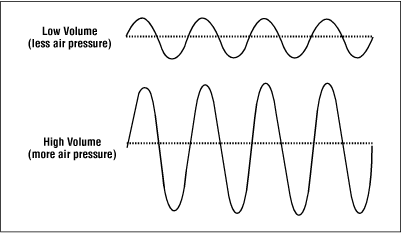The Physics of Waves
Sound
waves
are
pressure oscillations in the air or another
medium. The wave moves as the particles in the medium interact
with the particles next to them. Thomas Henderson notes, "as one air
particle is displaced from its equilibrium position, it exerts a push
or pull on its nearest neighbors, causing them to be displaced from
their equilibrium position" (Henderson). The speed of sound
in air at sea level is approximately 340 meters/second.

The crests are the points of maximum height above the
equilibrium and the troughs are the lowest points below the
equilibrium. The equilibrium is represented by the horizontal
line in the middle of the wave.
One period is the time it takes to go for one cycle, which means
to get from one crest to crest, trough to
trough, or to and from corresponding equilibrium points (both
equilibrium points same direction). The units for
period
are measured in seconds per cycle. The frequency of the wave is
the inverse of the wave length. The unit is Hertz, and it
measures cycles per second. The frequency is 1/period
and period is 1/frequency. The wavelength is often
denoted with the Greek letter lambda, and represents the length of the
cycle. The angular frequency is 2pi (frequency), and
that is in radians/second and often denoted with the Greek letter omega.

The amplitude of the wave is the height above the equilibrium point. In sound waves this corresponds to air pressure and volume. This becomes important for active noise cancellation because opposing waves can interfere with each other and cancel out the amplitude.